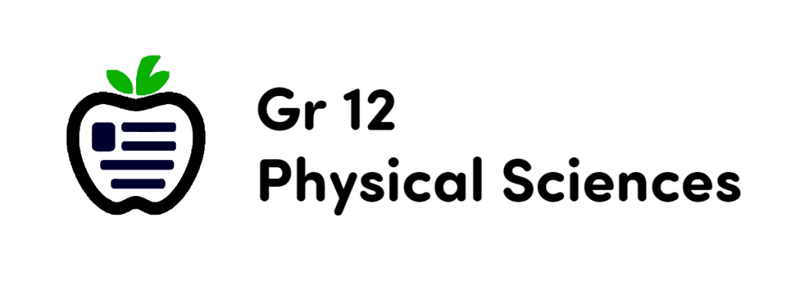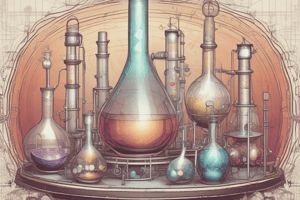Podcast
Questions and Answers
What is the purpose of stoichiometry?
What is the purpose of stoichiometry?
- To determine the temperature of a reaction
- To measure the volume of a chemical reaction
- To calculate the price of chemical reactions
- To calculate the reactants and products in chemical reactions (correct)
What is the difference between an empirical formula and a molecular formula?
What is the difference between an empirical formula and a molecular formula?
- Empirical formula gives the simplest ratio of atoms, while molecular formula gives the actual number of atoms (correct)
- Empirical formula is used for liquids, while molecular formula is used for solids
- Empirical formula gives the actual number of atoms, while molecular formula gives the simplest ratio of atoms
- Empirical formula is used for organic compounds, while molecular formula is used for inorganic compounds
What is the first step in determining the empirical formula of a compound?
What is the first step in determining the empirical formula of a compound?
- Divide all the values by the smallest number of moles obtained
- Divide the percentage composition by the atomic mass (correct)
- Round off the values to the nearest whole number
- Calculate the molar mass of the compound
What is the second step in determining the molecular formula of a compound?
What is the second step in determining the molecular formula of a compound?
Which of the following is not a more complex aspect of stoichiometry mentioned in the text?
Which of the following is not a more complex aspect of stoichiometry mentioned in the text?
What is the third step in determining the empirical formula of a compound?
What is the third step in determining the empirical formula of a compound?
What is the purpose of the molecular formula?
What is the purpose of the molecular formula?
What is the fourth step in determining the molecular formula of a compound?
What is the fourth step in determining the molecular formula of a compound?
Which of the following is not a more complex aspect of stoichiometry mentioned in the text?
Which of the following is not a more complex aspect of stoichiometry mentioned in the text?
What is the purpose of the empirical formula?
What is the purpose of the empirical formula?
What is the formula for calculating Percentage Yield?
What is the formula for calculating Percentage Yield?
What is the importance of Percentage Purity in chemical reactions?
What is the importance of Percentage Purity in chemical reactions?
Which step is NOT involved in Stoichiometric Calculations?
Which step is NOT involved in Stoichiometric Calculations?
How can you determine the Limiting Reagent in a chemical reaction?
How can you determine the Limiting Reagent in a chemical reaction?
In an empirical and molecular formula problem, what does the molar mass of the compound help determine?
In an empirical and molecular formula problem, what does the molar mass of the compound help determine?
What does Percentage Composition refer to in chemistry?
What does Percentage Composition refer to in chemistry?
When solving stoichiometric problems, what is the role of mole ratios from balanced equations?
When solving stoichiometric problems, what is the role of mole ratios from balanced equations?
Why is it essential to convert all given information into moles when performing stoichiometric calculations?
Why is it essential to convert all given information into moles when performing stoichiometric calculations?
What is Percentage Purity used for in chemical reactions?
What is Percentage Purity used for in chemical reactions?
What does Percentage Composition of an element in a compound express?
What does Percentage Composition of an element in a compound express?
What is the purpose of determining the empirical formula of a compound?
What is the purpose of determining the empirical formula of a compound?
Why is converting the given information into moles crucial in stoichiometric calculations?
Why is converting the given information into moles crucial in stoichiometric calculations?
Which step is necessary to determine the molecular formula of a compound?
Which step is necessary to determine the molecular formula of a compound?
In stoichiometry, what does the molecular formula represent?
In stoichiometry, what does the molecular formula represent?
When determining the empirical formula, what does rounding off to the nearest whole number achieve?
When determining the empirical formula, what does rounding off to the nearest whole number achieve?
What does the molar mass of a compound assist in determining when calculating the molecular formula?
What does the molar mass of a compound assist in determining when calculating the molecular formula?
In stoichiometry, why is it important to find the limiting reagent in a chemical reaction?
In stoichiometry, why is it important to find the limiting reagent in a chemical reaction?
What is one significant distinction between an empirical and molecular formula?
What is one significant distinction between an empirical and molecular formula?
What is not considered when calculating stoichiometric problems?
What is not considered when calculating stoichiometric problems?
Why is percentage purity an important aspect in chemical reactions?
Why is percentage purity an important aspect in chemical reactions?
What information is needed to calculate the percentage yield of a chemical reaction?
What information is needed to calculate the percentage yield of a chemical reaction?
Which of the following is NOT a step in performing stoichiometric calculations based on balanced equations?
Which of the following is NOT a step in performing stoichiometric calculations based on balanced equations?
What does the percentage composition of an element in a compound represent?
What does the percentage composition of an element in a compound represent?
If a compound contains 40% carbon, 6.7% hydrogen, and 53.3% oxygen by mass, and its molar mass is 180 g/mol, which of the following represents the empirical formula?
If a compound contains 40% carbon, 6.7% hydrogen, and 53.3% oxygen by mass, and its molar mass is 180 g/mol, which of the following represents the empirical formula?
In a chemical reaction, if the limiting reagent is completely consumed, what happens to the other reactants?
In a chemical reaction, if the limiting reagent is completely consumed, what happens to the other reactants?
If 25 grams of sodium chloride are produced from the reaction of 30 grams of sodium with chlorine gas, what is the percentage yield?
If 25 grams of sodium chloride are produced from the reaction of 30 grams of sodium with chlorine gas, what is the percentage yield?
In a reaction between 5 grams of nitrogen and 10 grams of hydrogen, if nitrogen is the limiting reagent, what is the maximum amount of ammonia (NH₃) that can be produced?
In a reaction between 5 grams of nitrogen and 10 grams of hydrogen, if nitrogen is the limiting reagent, what is the maximum amount of ammonia (NH₃) that can be produced?
What is the purpose of determining the empirical formula of a compound?
What is the purpose of determining the empirical formula of a compound?
If a 500 g sample of limestone (CaCO₃) is found to produce 280 g of pure calcium oxide upon heating, what is the percentage purity of the limestone?
If a 500 g sample of limestone (CaCO₃) is found to produce 280 g of pure calcium oxide upon heating, what is the percentage purity of the limestone?
What is the first step in determining the limiting reagent in a chemical reaction?
What is the first step in determining the limiting reagent in a chemical reaction?
What is the final step in determining the molecular formula of a compound?
What is the final step in determining the molecular formula of a compound?
What does rounding off to the nearest whole number achieve in determining the empirical formula of a compound?
What does rounding off to the nearest whole number achieve in determining the empirical formula of a compound?
Why is it crucial to calculate the empirical formula first before determining the molecular formula of a compound?
Why is it crucial to calculate the empirical formula first before determining the molecular formula of a compound?
What is one primary distinction between an empirical formula and a molecular formula?
What is one primary distinction between an empirical formula and a molecular formula?
When converting given information into moles for stoichiometric calculations, what does this process directly assist in determining?
When converting given information into moles for stoichiometric calculations, what does this process directly assist in determining?
Which calculation is necessary to determine the empirical formula of a compound?
Which calculation is necessary to determine the empirical formula of a compound?
What is significant about determining both empirical and molecular formulas of a compound in stoichiometry?
What is significant about determining both empirical and molecular formulas of a compound in stoichiometry?
'Divide all values by the smallest number of moles obtained' is a step specifically used for determining which type of formula?
'Divide all values by the smallest number of moles obtained' is a step specifically used for determining which type of formula?
What must you do in order to get the molecular formula after determining an empirical formula?
What must you do in order to get the molecular formula after determining an empirical formula?
What is the formula for calculating the Percentage Composition of an element in a compound?
What is the formula for calculating the Percentage Composition of an element in a compound?
In stoichiometric calculations, when converting moles back into required units, what is being determined?
In stoichiometric calculations, when converting moles back into required units, what is being determined?
What is the primary reason for determining the Empirical Formula of a compound?
What is the primary reason for determining the Empirical Formula of a compound?
Why is it crucial to use the coefficients of a balanced chemical equation in Stoichiometric Calculations?
Why is it crucial to use the coefficients of a balanced chemical equation in Stoichiometric Calculations?
What aspect does Percentage Purity focus on when dealing with impure reactants?
What aspect does Percentage Purity focus on when dealing with impure reactants?
Which step is essential to find the limiting reagent in a chemical reaction?
Which step is essential to find the limiting reagent in a chemical reaction?
When solving stoichiometric problems, what is achieved by rounding off to the nearest whole number in empirical formula calculations?
When solving stoichiometric problems, what is achieved by rounding off to the nearest whole number in empirical formula calculations?
What does Percentage Yield represent in a chemical reaction context?
What does Percentage Yield represent in a chemical reaction context?
Limiting Reagents determine which aspect related to chemical reactions?
Limiting Reagents determine which aspect related to chemical reactions?
Stoichiometric Calculations are used for converting between which units?
Stoichiometric Calculations are used for converting between which units?



